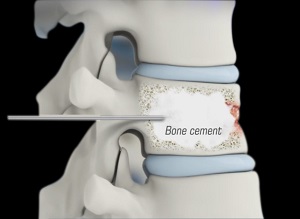
-
Kyphoplasty and vertebroplasty are a minimally invasive procedures to relieve pain due to vertebral compression fractures. The skilled team at Neuroscience Specialists offers expert care for a wide range of brain and spine conditions in Oklahoma City, OK. We also provide specialized aftercare to improve outcomes. Contact our office for an appointment today.

What is Vertebroplasty and Kyphoplasty?
Osteoporosis is a “silent” disease characterized by the weakening of bones. This makes the patients more susceptible to fractures, typically in the hip and spine. The elderly and post-menopausal women are at a greater risk of developing osteoporosis.
The mid to lower back area of the spine is mainly involved in weight-bearing, making these regions of the spine more prone to collapse when bones weaken. This can lead to spinal (vertebral) compression fractures. Compression fractures are broken spinal bones that cause a part of or a complete vertebra to collapse. Many of these vertebral compression fractures occur by minimal trauma or no trauma at all. They can even occur during simple activities like bending or twisting.
Symptoms of Osteoporosis
Symptoms range from severe pain in the back, arms and legs to no pain at all. Most patients suffering from such a fracture may believe that their back pain is just a part of aging, letting these vertebral compression fractures go undiagnosed.
A single vertebral fracture significantly increases a person’s risk of further fractures. When multiple fractures occur, it causes the spine to become rounded and bent forward resulting in loss of height and a hunchback appearance. This forward curvature of the spine negatively affects the quality of life of the patients and makes it more difficult for them to breathe, eat, walk, or sleep. Vertebral compression fractures can also occur in patients suffering from conditions such as a metastatic tumor, multiple myeloma, and vertebral hemangioma.
What are the treatment options?
Until recently, treatment of compression fractures included bed rest, bracing, pain medications or invasive spinal surgery. Currently, two new therapeutic and preventive treatment options are available for compression fractures, called vertebroplasty and kyphoplasty.
Vertebroplasty
Vertebroplasty is a minimally invasive procedure performed under general or local anesthesia. You will lie face down on the operating table. Using live X-ray imaging, your doctor will insert a large needle through the skin into the fractured vertebra and inject bone cement into it. The needle is then withdrawn before the cement hardens. The cement quickly hardens and provides strength and stability to the vertebra.
Kyphoplasty
Kyphoplasty is a minimally invasive procedure to relieve pain due to vertebral compression fracture. The procedure is similar to vertebroplasty and is performed under general or local anesthesia. You will lie face down on the operating table. Using live X-ray imaging, your doctor will insert a large needle through the skin into the vertebra and insert a balloon through the needle. The balloon is then inflated until the desired vertebral height is obtained. The balloon is then removed and the empty space created between the vertebrae is injected with cement. The cement quickly hardens restoring height and providing strength and stability to the vertebra.
What are the Steps taken for Post-Procedure Care?
Following vertebroplasty and kyphoplasty, you will be discharged, most likely on the same day of the procedure. No bracing is required after the treatment procedure. You will be advised to stay in bed for the first 24 hours, after which you can start walking and quickly return to your normal daily activities. If there is pain in the area where the needle was inserted, an ice pack can be applied. Driving should be avoided till the surgeon feels it is okay. Heavy lifting and any strenuous activities should also be avoided for at least 6 weeks after the surgery.
What are the Associated Risks and Complications?
Vertebroplasty and kyphoplasty are generally safe. As with any surgery, some risks can occur. Complications of surgery may include:
- Bleeding
- Infection
- Blood clots
- Reaction to anesthesia
- Leakage of the bone cement into the surrounding area
After vertebroplasty and kyphoplasty, you should experience considerable relief from pain and improved quality of life.
